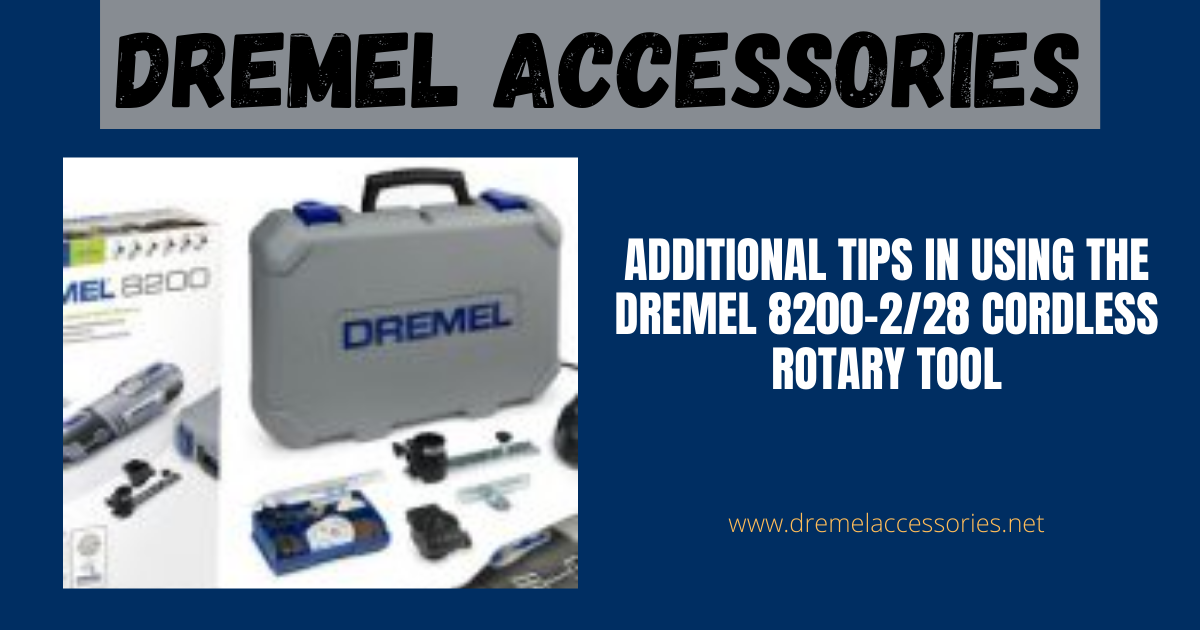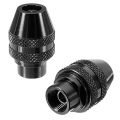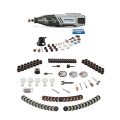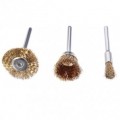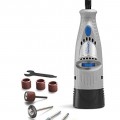Additional Tips in Using the Dremel 8200-2/28 Cordless Rotary Tool
By John Delaney
Here are some more tips and reminders for when you are using your Dremel 8200 rotary tool. Knowing these should make your efforts easier, safer, and more productive.
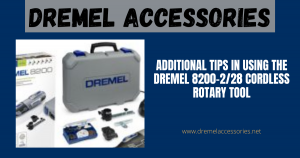 1. Always us the collet size which matches the shank size of the accessory you are going to use. There are 4 different collet sizes (1/32″, 1/16″, 3/32″, and 1/8″) available for the Dremel 8200. The 1/8″ size collet is normally included in most tool kits.
1. Always us the collet size which matches the shank size of the accessory you are going to use. There are 4 different collet sizes (1/32″, 1/16″, 3/32″, and 1/8″) available for the Dremel 8200. The 1/8″ size collet is normally included in most tool kits.
2. The 8200 comes with a built-in “hanger” that you can use to hang up your rotary tool when it is not in use. When you need to use your Dremel 8200, just snap the hanger back in place on the body of the rotary tool.
3. Make sure that your attached accessory is in balance on your rotary tool before you use it. After attaching your accessory, just turn on the rotary tool and you should be able to tell from the feel and the sound whether the attached accessory is in balance. To correct an imbalance, simply loosen the collet nut, twist the accessory a little, and retighten the collet nut. Then recheck the balance by restarting the rotary tool. You may need to perform these steps a couple of times until you are satisfied with the balance. The Dremel 8200 comes with a collet wrench.
4. When using wire brushes, never set the operating speed of the rotary tool at greater than 15,000 RPMs. Pieces of the wire brush may come loose during operation and become embedded in your skin. In addition, when you first attach a wire brush to your Dremel, turn on the Dremel and let it run for about a minute before using it. This 60-second warm up period should shake free any pieces of wire on the brush that are loose.
5. When using your tool for serious grinding or when using a cutoff wheel, grasp the body of the Dremel like you would hold a fishing rod – with your thumb on top near the OFF/ON switch, the body of the tool resting in the palm of your hand, and the other four fingers securing the left side of the tool.
6. Setting your rotary tool at a speed greater than 15,000 RPMs when using a bristle brush, may damage the brush.
7. When working with plastic, start your tool at a low rate of speed and gradually increase the speed until you see the plastic begin to melt. Then reduce your tool’s speed a little. This will give you the optimum working speed for that piece of plastic.
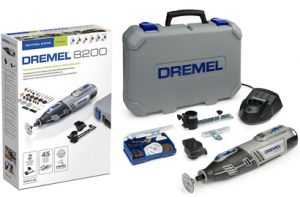 8. If the 3 lights on the fuel gauge begin flashing “off and on” that indicates your rotary tool’s battery has become too hot for use. Just turn off your tool, take a break, and let your tool cool down. (Note: If the 3 lights are flashing “side to side” or just 1 light is flashing “off and on”, that means that your battery needs to be recharged.)
8. If the 3 lights on the fuel gauge begin flashing “off and on” that indicates your rotary tool’s battery has become too hot for use. Just turn off your tool, take a break, and let your tool cool down. (Note: If the 3 lights are flashing “side to side” or just 1 light is flashing “off and on”, that means that your battery needs to be recharged.)
9. Just like with most cutting tools, never turn on your Dremel with it touching the material you are going to work on. Instead, start your Dremel and let it reach the full speed you set it for before you begin to cut/polish/sand/grind/etc the material.
10. If your tool bit binds up in the material you are working on, don’t worry. Your Dremel’s motor will stop automatically (a nice feature). Once you are able to unbind the tool’s bit from the material, the rotary tool will start up again automatically.
I hope these tips and reminders help!
For more information on Dremel rotary tools, you will want to check out this article on the Dremel 8200.
Article Source: Additional Tips in Using the Dremel 8200-2/28 Cordless Rotary Tool

